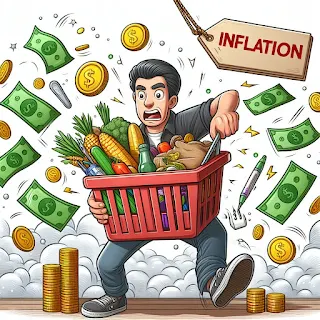Inflation is the general rise in the prices of goods and services in an economy over a period of time. It's like a shrinking value of money; as prices go up, your money can buy less and less. Think of it like a balloon inflating - the air inside expands, putting pressure on the sides and making it bigger. Similarly, with inflation, the overall price level in an economy expands, reducing the purchasing power of each unit of currency.
Here's how inflation works:
Causes of Inflation:
- Demand-pull inflation: This occurs when there's too much money chasing too few goods. When people have more money to spend than there are things to buy, businesses can raise prices because they know people are willing to pay more.
- Cost-push inflation: This happens when the cost of producing goods and services increases. This could be due to rising costs of raw materials, labor, or energy. Businesses pass these higher costs on to consumers in the form of higher prices.
Measuring Inflation:
The most common way to measure inflation is with the Consumer Price Index (CPI). The CPI tracks the prices of a basket of goods and services that households typically buy. The change in the CPI over time is expressed as a percentage, which is the inflation rate.
Effects of Inflation:
- Reduced purchasing power: As prices go up, your money can buy less. This can make it difficult to afford the things you need and want.
- Uncertainty and instability: High inflation can create uncertainty and instability in an economy, which can discourage investment and economic growth.
- Income inequality: Inflation can disproportionately hurt people with fixed incomes, such as retirees and those on low wages.
Controlling Inflation:
Central banks use monetary policy to try to control inflation. They can raise or lower interest rates to influence the amount of money in circulation. Higher interest rates make it more expensive to borrow money, which can slow down economic growth and reduce inflation.
Here are some additional things to keep in mind about inflation:
- A small amount of inflation is generally considered to be healthy for an economy. It can encourage businesses to invest and create jobs.
- Deflation, the opposite of inflation, can also be harmful to an economy. It can lead to businesses and consumers delaying spending, which can slow down economic growth.
- Inflation can be a complex issue with many different causes and effects. It's important to understand how inflation works so you can make informed decisions about your finances.
I hope this explanation helps! Let me know if you have any other questions.

Comments
Post a Comment